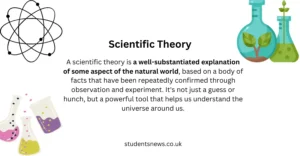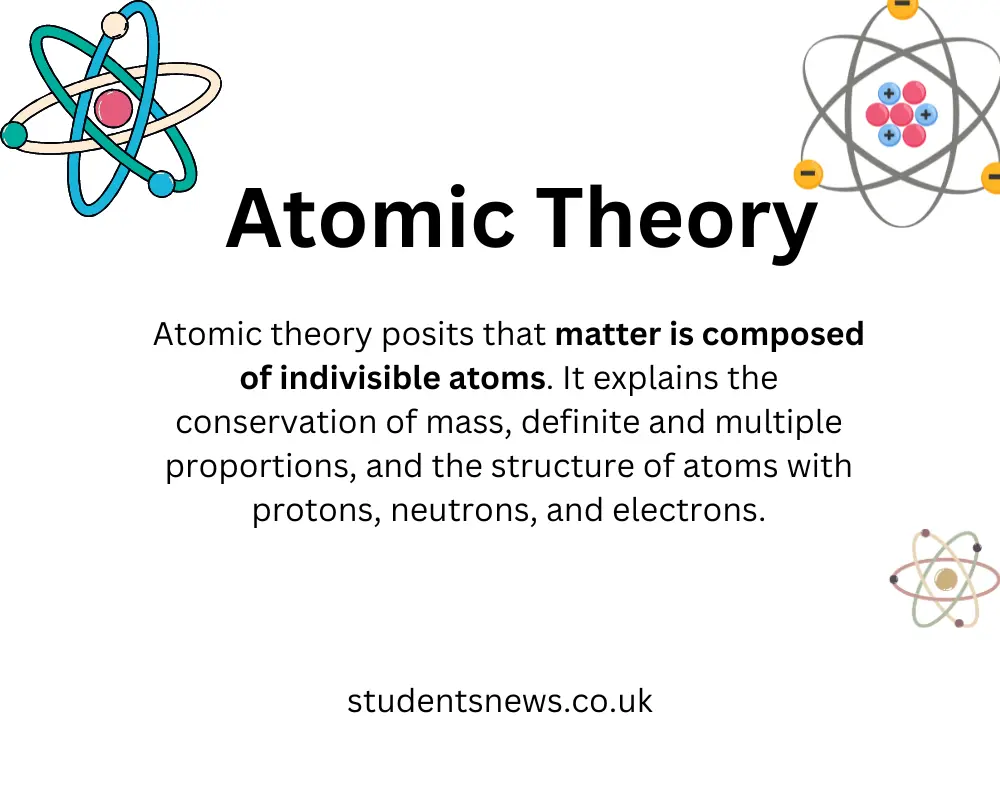The journey through the evolution of atomic theory is a captivating exploration into the fundamental understanding of matter. From ancient speculations to the complex world of quantum mechanics, each stage in the development of atomic theory has reshaped our perception of the universe. This blog post embarks on this enlightening voyage, tracing the threads of knowledge that weave the tapestry of atomic theory.

1. Ancient Wisdom and the Seeds of Thought (500 BCE – 17th Century CE)
The roots of atomic theory can be traced back to ancient Greek philosophers who pondered the nature of matter without the aid of sophisticated instruments. Democritus and Leucippus, in the 5th century BCE, introduced the concept of “atomos,” suggesting the existence of indivisible particles. Although their ideas lacked empirical support, they laid the conceptual groundwork for future scientific inquiry.
The ancient philosophers’ musings were constrained by a lack of experimental evidence, relying heavily on deductive reasoning. Despite these limitations, their notions of fundamental particles persisted and sparked curiosity in subsequent generations.
2. Dalton’s Pioneering Postulates (Early 19th Century)
The 19th century witnessed a renaissance in atomic thought with the work of John Dalton. Dalton’s atomic theory, formulated in the early 1800s, proposed that elements were composed of indivisible atoms. Each element had its unique atoms, and compounds formed through the combination of these atoms in fixed ratios. Similarly Marie Curie also contributed to the atomic theory.
Dalton’s postulates provided a conceptual framework for understanding chemical reactions, particularly the law of multiple proportions. Although the theory was revolutionary, subsequent advancements, such as the discovery of subatomic particles, prompted necessary modifications to Dalton’s model.
3. The Subatomic Frontier: Electrons and Nuclei (Late 19th to Early 20th Century)
The late 19th and early 20th centuries marked a pivotal era as scientists delved into the subatomic realm. J.J. Thomson’s cathode ray experiments in the late 1800s revealed the existence of negatively charged electrons. This discovery challenged the notion of indivisible atoms and paved the way for a more intricate understanding of atomic structure.
Rutherford’s gold foil experiment, conducted in the early 20th century, provided a breakthrough by demonstrating that the majority of an atom’s mass resides in a small, dense nucleus. This nucleus, composed of protons and neutrons, is orbited by electrons. The revelations from these experiments reshaped the atomic model and laid the foundation for future advancements.
4. Bohr’s Quantum Leap (Early to Mid-20th Century)
Niels Bohr, building on the discoveries of Thomson and Rutherford, proposed an atomic model that incorporated quantized electron orbits. Bohr’s model successfully explained the spectral lines observed in hydrogen, a phenomenon that earlier models had struggled to elucidate.
Bohr’s model introduced the idea that electrons occupy specific energy levels, and transitions between these levels correspond to the emission or absorption of energy. Despite its success in explaining certain phenomena, Bohr’s model faced challenges in accounting for more complex atoms. The quest for a more comprehensive understanding led to the emergence of quantum mechanics.
The early to mid-20th century saw a paradigm shift with the development of quantum mechanics. This revolutionary theory, pioneered by luminaries such as Werner Heisenberg and Erwin Schrödinger, described the behavior of particles at the atomic and subatomic levels. The wave-particle duality concept emerged, challenging classical notions of particle behavior.
Heisenberg’s uncertainty principle highlighted the inherent limitations in simultaneously measuring the position and momentum of a particle, further emphasizing the probabilistic nature of quantum mechanics. Schrödinger’s wave equation provided a mathematical framework for describing the behavior of electrons as waves rather than particles.
The integration of quantum mechanics into the understanding of atomic structure marked a significant departure from classical physics, opening new avenues for exploration in the microscopic world.
5. Quantum Mechanics Redefined (Mid-20th Century to Present)
The mid-20th century witnessed the refinement and consolidation of quantum mechanics into a comprehensive model of atomic behavior. The development of the quantum mechanical model replaced the deterministic trajectories of electrons with probability distributions.
In this model, electrons are described by wave functions, and the probability of finding an electron in a specific region is represented by atomic orbitals. Quantum numbers, including the principal, azimuthal, magnetic, and spin quantum numbers, emerged as tools to characterize these orbitals and the properties of electrons within them.
The introduction of the electron cloud model represented a departure from the simplistic, planetary orbits of early atomic models. It embraced the probabilistic nature of electrons, acknowledging that their precise locations within an orbital cannot be precisely determined.
This redefined understanding of atomic structure allowed for more accurate predictions of chemical behavior and bonding. The quantum mechanical model laid the groundwork for advancements in spectroscopy, computational chemistry, and our comprehension of the intricacies of atomic interactions.
6. Advances in Modern Atomic Theory (Late 20th Century to Present)
The late 20th century to the present era has been characterized by profound discoveries in the realm of particle physics, pushing the boundaries of our understanding of the subatomic world. The advent of powerful particle accelerators and detectors facilitated the exploration of previously elusive particles.
Advancements in theoretical frameworks, such as the development of the Standard Model, provided a unifying description of elementary particles and their interactions. This model successfully explained the electromagnetic, weak, and strong nuclear forces governing the behavior of particles, further cementing our understanding of the fundamental constituents of matter.
The late 20th century saw the discovery of quarks, the building blocks of protons and neutrons, revealing a deeper level of complexity within atomic nuclei. Neutrinos, once considered elusive, were detected, shedding light on the subtle interactions occurring within the subatomic realm.
One of the most significant milestones in modern atomic theory was the discovery of the Higgs boson in 2012 at CERN. This elusive particle, predicted by the Standard Model, plays a crucial role in explaining the origin of mass. Its discovery provided experimental confirmation of a key aspect of the fundamental framework governing particle physics.
Technological advancements continue to drive progress in atomic and subatomic research. Particle accelerators, such as the Large Hadron Collider (LHC), enable scientists to probe ever-higher energy regimes, unveiling new dimensions of the subatomic landscape. The integration of cutting-edge technologies, such as advanced detectors and computational methods, has transformed the field, allowing for unprecedented precision and depth in our exploration of atomic and subatomic structures.
7. Bridging the Scales: From Atoms to Molecules and Beyond
The evolution of atomic theory extends beyond understanding individual atoms to exploring their collective behavior in molecules and beyond. The mid-20th century saw the development of molecular orbital theory, which extends the principles of quantum mechanics to describe the behavior of electrons in molecules. This theory provides insights into the electronic structure and properties of compounds, forming the basis for our understanding of chemical bonding.
The emergence of nanotechnology in recent decades represents a groundbreaking application of atomic and molecular principles. Scientists and engineers manipulate materials at the nanoscale, where the properties of matter can differ significantly from those at larger scales. The design and fabrication of nanomaterials have led to innovations in medicine, electronics, and materials science, opening new possibilities for technological advancements.
Atomic force microscopy (AFM) and scanning tunneling microscopy (STM) have allowed scientists to visualize and manipulate individual atoms on surfaces. These techniques provide a direct window into the nanoscale world, enabling researchers to study and engineer materials with unprecedented precision.
In addition to practical applications, the exploration of atoms and molecules has contributed to a deeper understanding of the natural world. The study of molecular genetics, for example, relies on the principles of atomic and molecular interactions to elucidate the structure and function of biological macromolecules.
The interdisciplinary nature of atomic theory is evident in fields such as astrochemistry, where the study of atoms and molecules in space provides insights into the formation of celestial bodies and the conditions for life beyond Earth. The principles of atomic theory serve as a universal language, allowing scientists to interpret the composition of distant galaxies and the atmospheres of exoplanets.
As technology continues to advance, the bridge between the microscopic and macroscopic worlds strengthens. The principles derived from the evolution of atomic theory not only enhance our technological capabilities but also deepen our understanding of the interconnectedness of the natural world across different scales.
Conclusion
The evolution of atomic theory has been a fascinating journey, revealing the intricate dance of particles that form the foundation of our universe. From the speculative ideas of ancient philosophers to the precise predictions of modern quantum mechanics, each stage in this evolution has expanded our understanding of matter and its behavior.
As we reflect on the key milestones outlined in this exploration, it becomes evident that atomic theory is not a static concept but a dynamic framework that continuously adapts to new discoveries. The journey from Dalton’s simple atomic model to the complex intricacies of the Standard Model demonstrates the relentless pursuit of knowledge and the collaborative efforts of countless scientists across centuries.
The implications of atomic theory extend far beyond the realm of scientific curiosity. The practical applications of atomic principles in technology, medicine, and materials science underscore the transformative power of understanding the fundamental building blocks of matter.
As we stand on the shoulders of giants who have paved the way for our current understanding, it is crucial to recognize the ongoing nature of scientific inquiry. The mysteries that remain unsolved, the frontiers yet to be explored, and the potential for future breakthroughs remind us that the evolution of atomic theory is an ever-unfolding narrative.
In conclusion, the story of atomic theory is not just a chronicle of scientific progress but a testament to human curiosity, ingenuity, and the unyielding quest for knowledge. As we navigate the complexities of the atomic world, we embark on a perpetual journey of exploration, uncovering the secrets that shape the very fabric of our existence.



[…] spontaneous decay, emitting radiation in the process. This observation was a pivotal moment in the history of atomic theory. It paved the way for future scientists to investigate the nature of radioactivity and explore the […]